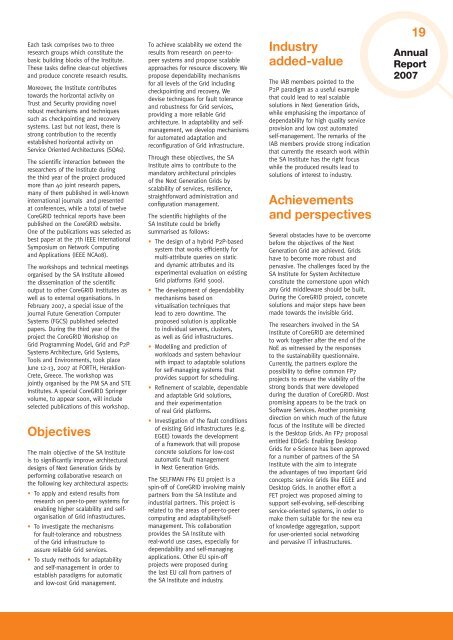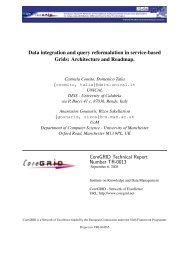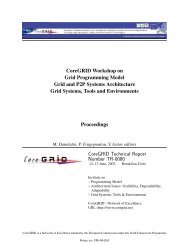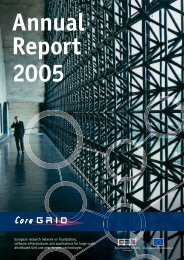Annual report for download - CoreGRID Network of Excellence
Annual report for download - CoreGRID Network of Excellence
Annual report for download - CoreGRID Network of Excellence
Create successful ePaper yourself
Turn your PDF publications into a flip-book with our unique Google optimized e-Paper software.
Each task comprises two to threeresearch groups which constitute thebasic building blocks <strong>of</strong> the Institute.These tasks define clear-cut objectivesand produce concrete research results.Moreover, the Institute contributestowards the horizontal activity onTrust and Security providing novelrobust mechanisms and techniquessuch as checkpointing and recoverysystems. Last but not least, there isstrong contribution to the recentlyestablished horizontal activity onService Oriented Architectures (SOAs).The scientific interaction between theresearchers <strong>of</strong> the Institute duringthe third year <strong>of</strong> the project producedmore than 40 joint research papers,many <strong>of</strong> them published in well-knowninternational journals and presentedat conferences, while a total <strong>of</strong> twelve<strong>CoreGRID</strong> technical <strong>report</strong>s have beenpublished on the <strong>CoreGRID</strong> website.One <strong>of</strong> the publications was selected asbest paper at the 7th IEEE InternationalSymposium on <strong>Network</strong> Computingand Applications (IEEE NCA08).The workshops and technical meetingsorganised by the SA Institute allowedthe dissemination <strong>of</strong> the scientificoutput to other <strong>CoreGRID</strong> Institutes aswell as to external organisations. InFebruary 2007, a special issue <strong>of</strong> thejournal Future Generation ComputerSystems (FGCS) published selectedpapers. During the third year <strong>of</strong> theproject the <strong>CoreGRID</strong> Workshop onGrid Programming Model, Grid and P2PSystems Architecture, Grid Systems,Tools and Environments, took placeJune 12-13, 2007 at FORTH, Heraklion-Crete, Greece. The workshop wasjointly organised by the PM SA and STEInstitutes. A special <strong>CoreGRID</strong> Springervolume, to appear soon, will includeselected publications <strong>of</strong> this workshop.ObjectivesThe main objective <strong>of</strong> the SA Instituteis to significantly improve architecturaldesigns <strong>of</strong> Next Generation Grids byper<strong>for</strong>ming collaborative research onthe following key architectural aspects:• To apply and extend results fromresearch on peer-to-peer systems <strong>for</strong>enabling higher scalability and sel<strong>for</strong>ganisation<strong>of</strong> Grid infrastructures.• To investigate the mechanisms<strong>for</strong> fault-tolerance and robustness<strong>of</strong> the Grid infrastructure toassure reliable Grid services.• To study methods <strong>for</strong> adaptabilityand self-management in order toestablish paradigms <strong>for</strong> automaticand low-cost Grid management.To achieve scalability we extend theresults from research on peer-topeersystems and propose scalableapproaches <strong>for</strong> resource discovery. Wepropose dependability mechanisms<strong>for</strong> all levels <strong>of</strong> the Grid includingcheckpointing and recovery. Wedevise techniques <strong>for</strong> fault toleranceand robustness <strong>for</strong> Grid services,providing a more reliable Gridarchitecture. In adaptability and selfmanagement,we develop mechanisms<strong>for</strong> automated adaptation andreconfiguration <strong>of</strong> Grid infrastructure.Through these objectives, the SAInstitute aims to contribute to themandatory architectural principles<strong>of</strong> the Next Generation Grids byscalability <strong>of</strong> services, resilience,straight<strong>for</strong>ward administration andconfiguration management.The scientific highlights <strong>of</strong> theSA Institute could be brieflysummarised as follows:• The design <strong>of</strong> a hybrid P2P-basedsystem that works efficiently <strong>for</strong>multi-attribute queries on staticand dynamic attributes and itsexperimental evaluation on existingGrid plat<strong>for</strong>ms (Grid 5000).• The development <strong>of</strong> dependabilitymechanisms based onvirtualisation techniques thatlead to zero downtime. Theproposed solution is applicableto individual servers, clusters,as well as Grid infrastructures.• Modelling and prediction <strong>of</strong>workloads and system behaviourwith impact to adaptable solutions<strong>for</strong> self-managing systems thatprovides support <strong>for</strong> scheduling.• Refinement <strong>of</strong> scalable, dependableand adaptable Grid solutions,and their experimentation<strong>of</strong> real Grid plat<strong>for</strong>ms.• Investigation <strong>of</strong> the fault conditions<strong>of</strong> existing Grid infrastructures (e.g.EGEE) towards the development<strong>of</strong> a framework that will proposeconcrete solutions <strong>for</strong> low-costautomatic fault managementin Next Generation Grids.The SELFMAN FP6 EU project is aspin-<strong>of</strong>f <strong>of</strong> <strong>CoreGRID</strong> involving mainlypartners from the SA Institute andindustrial partners. This project isrelated to the areas <strong>of</strong> peer-to-peercomputing and adaptability/selfmanagement.This collaborationprovides the SA Institute withreal-world use cases, especially <strong>for</strong>dependability and self-managingapplications. Other EU spin-<strong>of</strong>fprojects were proposed duringthe last EU call from partners <strong>of</strong>the SA Institute and industry.Industryadded-valueThe IAB members pointed to theP2P paradigm as a useful examplethat could lead to real scalablesolutions in Next Generation Grids,while emphasising the importance <strong>of</strong>dependability <strong>for</strong> high quality serviceprovision and low cost automatedself-management. The remarks <strong>of</strong> theIAB members provide strong indicationthat currently the research work withinthe SA Institute has the right focuswhile the produced results lead tosolutions <strong>of</strong> interest to industry.Achievementsand perspectivesSeveral obstacles have to be overcomebe<strong>for</strong>e the objectives <strong>of</strong> the NextGeneration Grid are achieved. Gridshave to become more robust andpervasive. The challenges faced by theSA Institute <strong>for</strong> System Architectureconstitute the cornerstone upon whichany Grid middleware should be built.During the <strong>CoreGRID</strong> project, concretesolutions and major steps have beenmade towards the invisible Grid.The researchers involved in the SAInstitute <strong>of</strong> <strong>CoreGRID</strong> are determinedto work together after the end <strong>of</strong> theNoE as witnessed by the responsesto the sustainability questionnaire.Currently, the partners explore thepossibility to define common FP7projects to ensure the viability <strong>of</strong> thestrong bonds that were developedduring the duration <strong>of</strong> <strong>CoreGRID</strong>. Mostpromising appears to be the track onS<strong>of</strong>tware Services. Another promisingdirection on which much <strong>of</strong> the futurefocus <strong>of</strong> the Institute will be directedis the Desktop Grids. An FP7 proposalentitled EDGeS: Enabling DesktopGrids <strong>for</strong> e-Science has been approved<strong>for</strong> a number <strong>of</strong> partners <strong>of</strong> the SAInstitute with the aim to integratethe advantages <strong>of</strong> two important Gridconcepts: service Grids like EGEE andDesktop Grids. In another ef<strong>for</strong>t aFET project was proposed aiming tosupport self-evolving, self-describingservice-oriented systems, in order tomake them suitable <strong>for</strong> the new era<strong>of</strong> knowledge aggregation, support<strong>for</strong> user-oriented social networkingand pervasive IT infrastructures.19<strong>Annual</strong>Report2007








